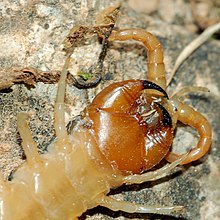A centipede bite is an injury resulting from the action of a centipede's forcipules, stinger-like appendages that pierce the skin and inject venom into the wound. Such a wound is not strictly speaking a bite, as the forcipules are a modified first pair of legs rather than true mouthparts. Clinically, the wound is viewed as a cutaneous condition characterized by paired hemorrhagic marks that form a chevron shape caused by the paired forcipules.[1]
| Centipede bite | |
|---|---|
 | |
| Underside of Scolopendra cingulata, showing the forcipules |
The centipede's venom causes pain and swelling in the area of the bite, and may cause other reactions throughout the body. The majority of bites are not life-threatening to humans and present the greatest risk to children and those who develop allergic reactions.[2][3]
Symptoms and signs
editSymptoms which are most likely to develop include:[4]
Other symptoms such as hardening of the skin and tissue death may also occur.[5] In rare cases, Wells syndrome may also develop.[6]
Diagnosis
editThis section is empty. You can help by adding to it. (February 2023) |
Treatment
editCentipedes bites, while painful, rarely cause severe health complications in people. Centipede venoms are heat-labile, and warm-water immersion may help reduce pain and swelling. Icing also helps.[7]
Society and culture
editNaturalist Jacques-Henri Bernardin de Saint-Pierre reported that his dog developed a serious ulcer after a centipede bite during travels in Mauritius.[8]
YouTube personality Coyote Peterson has been intentionally bitten by Scolopendra heros (giant desert centipede) and declares that the pain caused by the bite is worse than a bullet ant sting.[9][10]
Muay Thai fighter Dokmaipa Por Pongsawang died after a bite from an arthropod described as a takhap (large centipede).[11] Taiwanese folk musician Difang Duana's death was accelerated by a centipede bite he suffered six months earlier.[12] Both Pongsawang and Duana were diabetic.[11][12]
See also
editReferences
edit- ^ James, William D.; Berger, Timothy G.; et al. (2006). Andrews' Diseases of the Skin: clinical Dermatology. Saunders Elsevier. ISBN 0-7216-2921-0.
- ^ "Centipede Bite". Orkin. 2011. Retrieved April 29, 2011.
- ^ Sean P. Bush; Bradley O. King; Robert L. Norris; Scott A. Stockwell (2001). "Centipede envenomation". Wilderness & Environmental Medicine. 12 (2): 93–99. doi:10.1580/1080-6032(2001)012[0093:CE]2.0.CO;2. PMID 11434497.
- ^ "Do Centipedes Bite? | Get Rid of Centipedes | Orkin".
- ^ "Centipede bites: Effects and treatment". Retrieved 2022-10-04.
- ^ "Scolopendra - an overview | ScienceDirect Topics". www.sciencedirect.com. Retrieved 2022-10-04.
- ^ "Centipede Stings".
- ^ Henri Bernardin de Saint-Pierre, Voyage à l'Isle de France, à l'Isle de Bourbon, au Cap de Bonne-Espérance, etc. avec des observations nouvelles sur la nature et sur les hommes (Paris: 1773), p. 128.
- ^ Centipede Bite Worse Than ALL Stings?!, retrieved 2021-12-30
- ^ "This Maniac Let a Giant Centipede Give Him One of the World's Most Painful Bug Bites". 20 December 2017.
- ^ a b "Muay Thai champ dies from bite blamed on monster centipede". Coconuts Thailand. 8 October 2020. Retrieved 17 February 2023.
- ^ a b Huang, Sandy (March 30, 2002). "Amis singer Difang passes away". Taipei Times. Retrieved 2012-04-19.